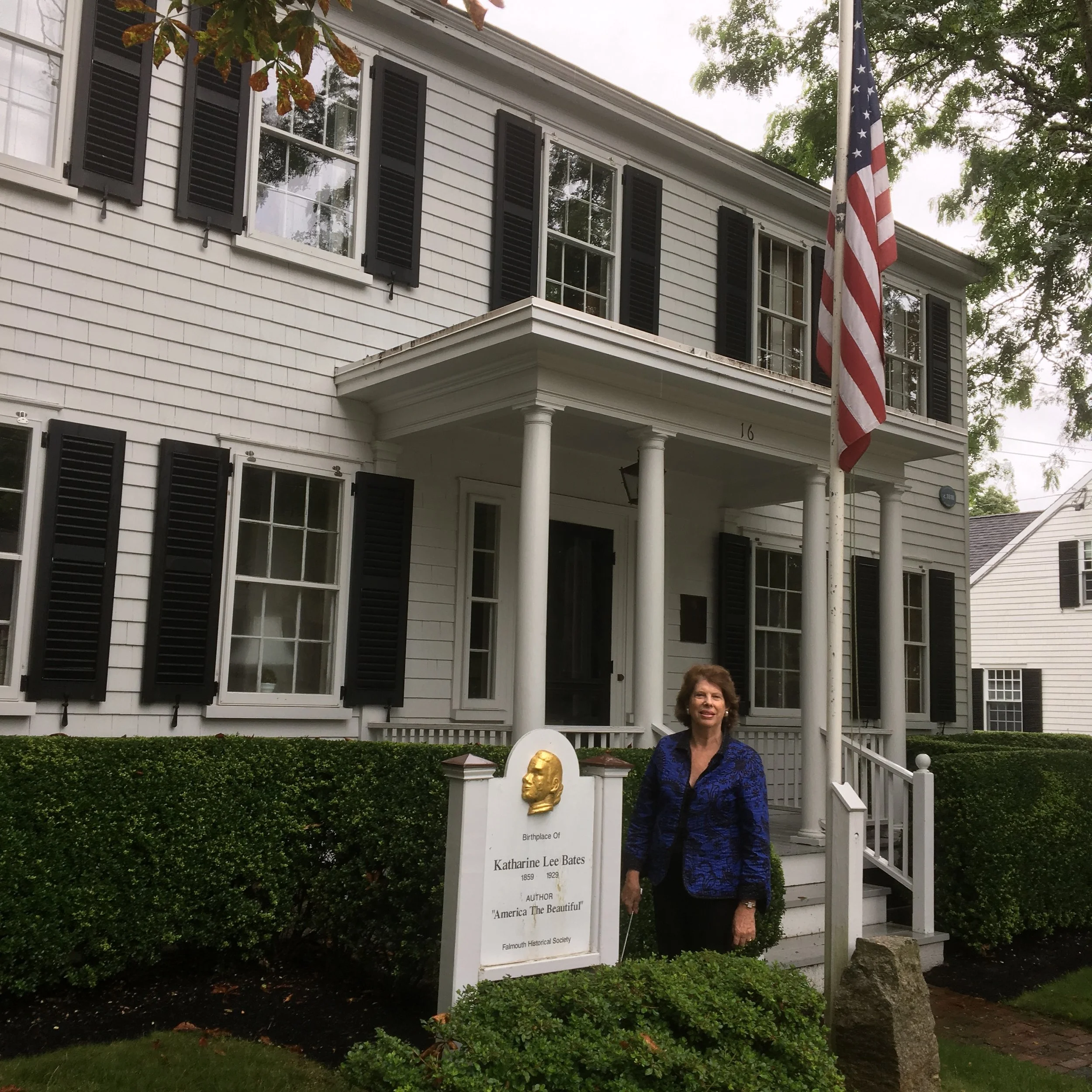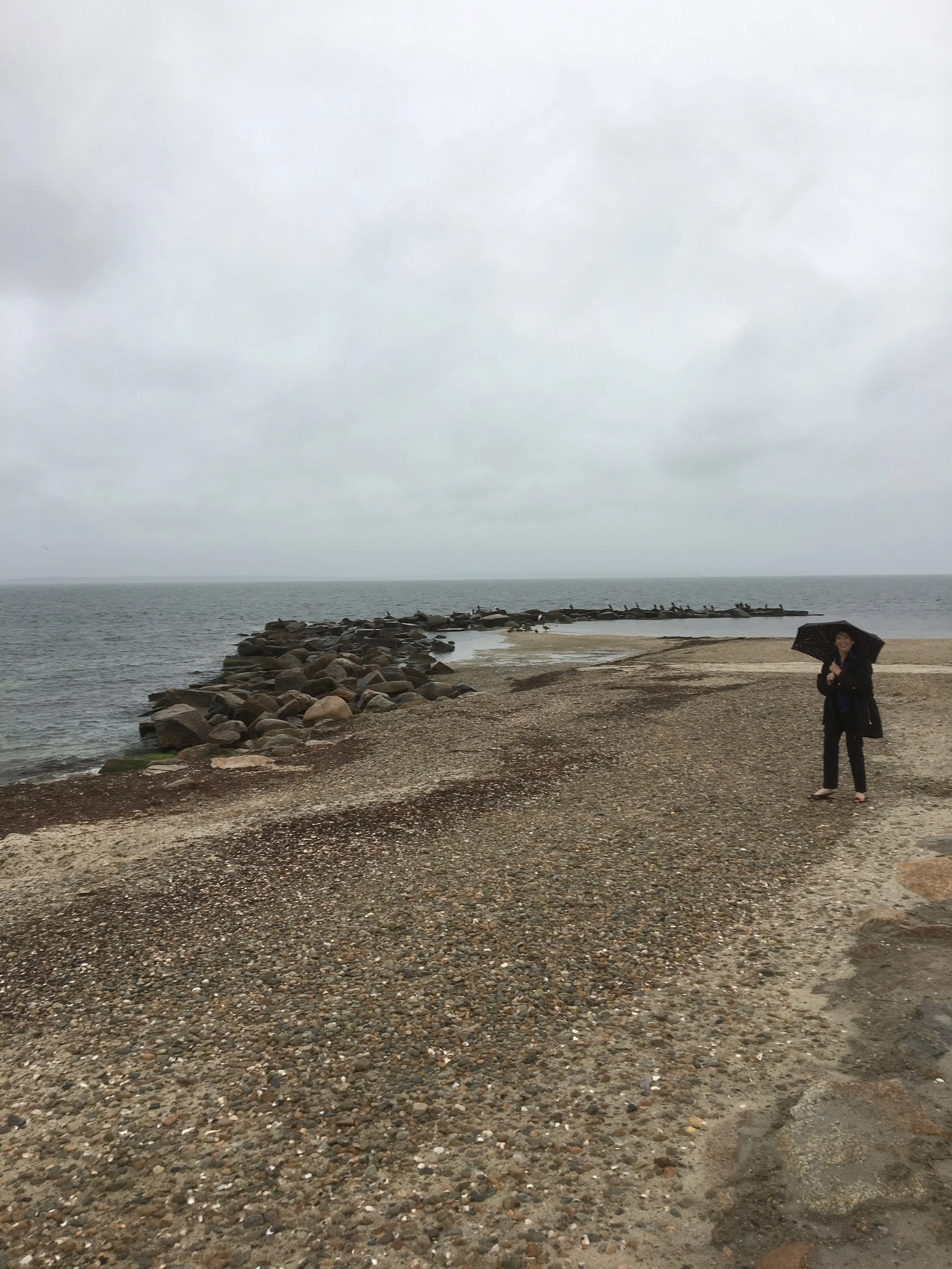Katharine Lee Bates in 1925 in her study, photo courtesy of Melinda M. Ponder and the Wellesley College Archives
Most people know Francis Scott Key wrote “The Star-Spangled Banner.” Some people know that Irving Berlin wrote “God Bless America.” But on my author visits to schools across the country, I found that hardly anyone — kids or teachers — knows who wrote “America the Beautiful.”
That’s why I’ve been so excited to work on FOR SPACIOUS SKIES, KATHARINE LEE BATES AND THE INSPIRATION FOR ‘AMERICA THE BEAUTIFUL,’ a picture book biography of the poet, suffragette and Wellesley English professor who wrote this beautiful poem that became one of America’s most famous and beloved songs.
The book, edited by Wendy McClure (a wonderful author in her own right), releases April 2020 from Albert Whitman & Company, with fabulous illustrations by Olga Baumert that will make you feel the spray of the waves in Katharine’s native Falmouth, Massachusetts. I’m thankful to Katharine Lee Bates’s great-great-grandnieces, Katharine Lee Holland and Elizabeth Olmstead Null and author Melinda M. Ponder for their help in reading the manuscript for accuracy.
I think Katharine would be pleased to see an all-women team making her picture book biography happen!
While it’s too soon to show you a cover (or provide you with a pre-order link!), I want to celebrate Katharine now — because Aug. 12, 1859 marks her 160th birthday. Happily we can celebrate now with the wonderful adult biography, Katharine Lee Bates, From Sea to Shining Sea, by Melinda M. Ponder who, like Katharine, is a Wellesley graduate who has gone on to become a professor. Not only has Melinda written a terrific, detailed and impressively researched book, she has been kind enough to encourage and help me with my own research for my picture book biography.
Thank you, Melinda for taking time to answer questions about Katharine and your book!
What inspired you to write about Katharine Lee Bates?
When I was nine years old, I learned to sing “America the Beautiful” at school in Indianapolis, and my mother proudly told me that a woman from her women’s college, Wellesley College, had written it. But I didn’t realize then how surprising it was that a woman could write such a song! And when I went to Wellesley College myself, we sang all four of its verses on special occasions. But it was not until years later, when I was on a panel with three other experts on the great American author Nathaniel Hawthorne, that we singled out wonderful commentaries by someone named Katharine Lee Bates as the very best. I wondered if this woman could possibly be the poet of “America the Beautiful”…..How could she have written such patriotic words and also know so much about Hawthorne?
Since I had been looking for a little-known woman to write about, I went to the Wellesley College archives to check out she had written. There I found boxes of her letters, diaries, her more than 30 published books, and best of all, the scrapbooks into which she had pasted every tiny clipping of the many poems and stories that she had published in newspapers and magazines, since she was quite a popular writer. Once I started reading them, I tried to imagine her life more than 150 years ago.
Katharine Lee Bates as an infant, courtesy of Melinda M. Ponder and the Wellesley College Archives
To do that, I became a detective, searching out newspaper stories that chronicled American life from 1859-1929, Katharine’s lifetime. I tracked down Wellesley graduates who could tell me what it was like to be her student, especially when she taught classes in her home that she called The Scarab, named for an insect that she said was “always climbing,” as Katharine herself was throughout her life, traveling to distant countries, speaking up for exploited factory workers and for girls to be educated. I got to know Bates family members who remembered their aunt, one of whom told me that my biography of her had brought her back to life for him!
Since Katharine had loved to travel, I went to the places that were important to her—her birthplace on Cape Cod, Boston, Chicago, Colorado, London, Oxford, Spain, Egypt, and the Verdun, France battlefields where soldiers had stood and sung “America the Beautiful” when the war stopped on Nov. 11, 1918. I wanted to understand what each place had meant to her.
Melinda M. Ponder at the house where Katharine Lee Bates was born and raised in Falmouth, Massachusetts
As we approach what would have been her 160th birthday, what do you want readers to know about her?
Katharine Lee Bates was a complicated, multi-faceted woman who wanted Americans to learn about their history, their writers, and each other. She was a trailblazer who wanted to create a kind of Inclusive global community. She used her talents as a writer to help her readers empathize with people from different classes and nations.
Did you know from the start how you were going to structure the book and that you would call it Katharine Lee Bates: From Sea to Shining Sea? Or did you discover all this on your journey with the writing?
I loved doing research on Katharine for fifteen years, even though I was busy teaching at a women’s college. Then I spent ten more years writing and revising Katharine’s story so that readers could feel that they knew her and root for her. Having moved from the Midwest to Boston myself, I loved the seacoast and could picture Katharine’s childhood, as she put it, “rock’d in a clamshell.” She read and wrote poems about early explorers and adored beginning each of her many journeys, writing, the “tide is calling: the anchors lift." So I saw her life as a long journey to reach more readers and make America better. The more I worked on the book, that became its theme, especially because, at the end of her life, she saw that her words about the “sea to shining sea” could describe the seas circling the globe and creating one giant community.
Melinda M. Ponder on the seacoast of Katharine Lee Bates’ childhood
Did anything surprise you or move you unexpectedly in the course of your research?
Once I found a strand of her hair in her diary! But I also discovered the two men who courted and loved her. But in those days, she could not have remained a Wellesley professor if she had married. This was a painful dilemma for her, since she needed to support herself, and very few careers were open to women. So she never married, but she was surrounded at Wellesley by young energetic colleagues, social activists who pulled her into the challenges facing America after the Civil War of overcrowded cities, unfair working conditions, and immigrants who needed help. And her creative drive enabled her to be a social activist through what she wrote.
What was it like for you as an alumna of Katharine Lee Bates’ school, Wellesley College, to walk on the same ground she walked? Did that give you any special insight or connection with her?
Although the campus has many new buildings since Katharine’s days there, it is still a beautiful place on a lake, with giant trees and lovely landscaping. But I gained a new appreciation of the college working on my book as I learned about its early history. Its creator and founder was a man who believed that his female students could re-form the country after the Civil War. He was an important mentor to Katharine because he understood her burning desire to become a poet since he had once had that dream himself. He took Katharine to meet his poet friend Henry Wadsworth Longfellow, then a rock star as a popular poet, who praised Katharine’s poem in the Atlantic Monthly. I could imagine her visit in detail since I live down the street from Longfellow’s house.
Wellesley’s College Hall that Katharine entered in 1876 in the class of 1880 to become “Katie of ’80.” Photo courtesy of Melinda M. Ponder and the Wellesley College Archives
I get the sense that as an English professor yourself at Pine Manor College, you have a strong identification with Katharine Lee Bates. Can you tell me what insights your life has given you into hers and what insights studying her life has given you into your own?
Yes, I was interested in how she brought poetry to life for her students, how she mentored younger poets like Robert Frost, and I understood how she felt when she wrote, “Lived through classes only to play golf…”!
I am very grateful to you for the help and support you’ve given me with the picture book I’ve written for children, For Spacious Skies, Katharine Lee Bates and the Inspiration for “America the Beautiful” coming out in April 2020 from Albert Whitman & Company. How do you feel about a new generation of kids knowing about this amazing woman and what she contributed to America?
It is wonderful that kids will know about her at an early age since her favorite audiences were children and young people. I hope children who read your book, when they are a little older, will want to read the book that I am working on now-- a biography of Katharine Lee Bates for middle-grade readers. And what a great role model she is for us all as a fearless woman who still helps Americans voice their love for their country when we sing her words.
Melinda M. Ponder, Author
Katharine Lee Bates: From Sea to Shining Sea (available on Amazon here)
Facebook: KatharineLeeBatesBOOK
Twitter: melinda_ponder
Instagram: katharineleebates
Melinda M. Ponder
When Katharine returned to teach at Wellesley in 1885, she was greeted by young president Alice Freeman, second from left standing next to the column, appointed when she was 26 years old. Photo courtesy of Melinda M. Ponder and the Wellesley College Archives








